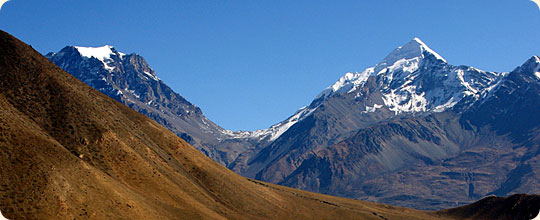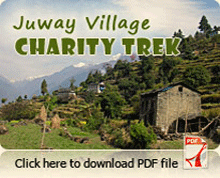

Nepal
Nepal, the country of high Himalayas, majestic mountains, strange wildlife and diverse cultures is a world in itself. Nepal has a unique landscape stretches from the pinnacle of Mt. Everest to the Terai low lands where diverse human cultures and natural habitats can be found. Nepal is the birth place of Lord Buddha. Roughly rectangular in shape, Nepal is sandwiched between China in the north and India in South. The length of the kingdom is approximately 885 km east to west, and breadth 193 km north to south. The total area of the country is 147, 181 sq.km. Kathmandu is the capital city of Nepal. Basically the visitors come to this country seeking yetis, others for tigers, some are in search of nirvana and many come to trek on ancient trail. Nepal is rich in terms of bio-diversity due to its unique geographical location variation in altitude. Within a distance of 150km, the elevation of the country ranges from 60 meters above sea level to the highest point on earth, Mt. Everest (8,848m.). The climate is also diverse in nature ranging from Sub-tropical to Arctic due to country's altitudinal variation. Nepal has occupied only 1% of the earth but it is a home to 2% of all the flowering plants in the world, 8% of the world's population of birds, 4% of mammals on earth, 11 of the world's 15 families of butterflies, 600 indigenous plant families and 319 species of exotic orchids. The national language of Nepal is Nepali, however; the people engaged in travel-trade understand and speak English fluently. The currency of Nepal is Nepali Rupee.

Nepal Map
Geography
Nepal has such a topographical contrast that elevation ranges from 70 meters above sea level in Jhapa to world's highest mountain, Mt Everest 8848m above sea level. This extreme variation has given Nepal a varied eco system, both thick tropical and alpine forest swarmed with diverse wildlife, great peaks of the world, frozen valleys, deep gorges, thundering Himalayan rivers running down the hills and cool and calm lakes.
History:
Nepal has always been an independent and sovereign country with glorious history, culture and tradition that date back to times immemorial. The people of Nepal are popular for their bravery in warfare, mountaineering, hospitality and sincerity since history. Before the campaign for national unification, this small kingdom was divided into smaller states. Kathmandu valley was ruled by the Malla Kings. They focused on promotion and development of Nepali arts and crafts. Thus, their contribution to art and culture are indeed great and unique. In 1768 A.D., the Shah dynasty ascended the throne of unified Nepal. The different cultures of this Himalayan country reflect harmonious blending of Hinduism and Buddhism. It is worthy to mention that Nepal is one of the founder members of the South Asian Association for Regional Cooperation (SAARC).
Culture
Nepal is a Himalayan country with cultural diverity. It is the holy land of Lord Pashupatinath and Gautam Buddha where the people of all religions have been living in harmony for centuries. The sacred Hindu shrine, the Temple of Pashupatinath is one of the important temples in the world among Shiva worshippers. Nepal is also a sacred pilgrimage destinations for Buddhists as Lord Buddha, the light of Asia, was born in Lumbini in Nepal's southern plains. Patan, Kathmandu and Bhaktapur, the three ancient cities of Kathmandu Valley symbolize an epitome of harmony in urban design, elegant architecture and refined culture. These cities domicile a concentration of religious monuments found nowhere in the world. The seven monument zones enlisted in the World Heritage Sites by UNESCO are situated within the small limit of the Valley. The landlocked country is also a land of festivals. On an average, at least one festival is celebrated per day in a traditional manner throughout the year which adds dazzling color to Nepal's myriad attractions, enduring customs and beliefs. In Nepal, one can easily enjoy village tours and visit the multi-ethnic groups to obtain first hand experience of their customs and lifestyles. Eating is a special affair in Nepal. vriety of food are served for each occasion and festival. Kathmandu, the capital city of Nepal, offers an incredible selection of dining opportunities.
Nature
Nepal is a wonderful land considering its its unique but vried lndcape and ntural beauty. It is a world in itself. Nepal offers an amazing topographical variation with altitude ranging from 70 m to 8,848 m just within a span of 193 km. Thus, due to its topographical variation, Nepal boasts all kinds of climate ranging from alpine, temperate to tropical. Similarly, the flora from tundra-like vegetation to desert-type cactuses and rainforest are found in this highland. In the same way, fauna from prairie dog-like Marmot to snow leopard to dolphin are available in Nepal. It is a mater of pleasure to mention that Nepal is also a home of countless river, glacial lakes, lakes, and creeks with their common origin in the Himalaya. Nepal holds more than 70 ethnic groups, each with its own unique culture and language. These people are basically spreading in hamlets, villages and shantytowns. Temples, shrines, all year long festivals, etc. add additional beauty to this paradise. Of the total of 14 peaks above 8,000 metres, Nepal is hoe to eight of the world's highest mountains, including Mt. Everest (8,848 m). Nepal's geography holds an exceptionally varied landscape. Hence, this wild variation fosters an incredible variety of ecosystems. Nepal has nine national parks and three wildlife reserves ranging from the highest mountains in the world as well as tropical lowland of the plains.It is recommended to explore the exotic Himalayan nature and culture of Nepal by walking through the villages and meeting the charming people.
People & Customs
The total population of Nepal is about 23.1 million (Population Census 2001). About eighty six percent of Nepalese follow Hinduism; eight percent Buddhism and the rest three percent follow Islam. The population comprises various groups of different races with diverse culture, languages and dialects. Some of the main groups are Gurungs and Magars in the western region; Rais, Limbus and Sunwars in the eastern mid hills; Sherpas, Manangpas and Lopas in the northern part, Newars in and around the capital valley of Kathmandu; Tharus, Yadavas, Satar, Rajvanshis and Dhimals in the Terai region; and Brahmins, Chhetris and Thakur are generally spread throughout the country.
Art
It is a matter of fact that Nepali art has been deeply influenced by religion since immemorial past. Nepali art was rapidly developed during the period of Malla Kings. Much focus was given for stone sculpture and temple architecture in the early days. Newari Paubha and Tibetan Thanka paintings, wood and metal crafts, ceramics and clay pots, textiles, paper, Tibetan carpet, music and literature are some other famous arts of Nepal. Traditional idealistic paintings and the contemporary western style works are the two distinct segments of contemporary Nepali art. The contemporary painting is basically based on either nature based compositions or compositions based on Tantric elements or social themes. Kathmandu Valley boards plethora of art galleries and museums galleries exhibiting artwork of ancient past and present. The National Museum at Chhauni, Museums at Kathmandu Durbar Square, Museum of Natural History at Swayambhu, National Library at Puchowk, Kaiser Library at Thamel, National Birendra Art Gallery at Naxal, Asa Archives at Tangal, National Art Gallery at Bhaktapur Durbar Square, National Woodworking Museum at Bhaktapur Durbar Square, Bronze and Brass Museum at Bhaktapur, Nepal National Ehnographic Museum at Bhrikuti Mandap are some of them in the valley. Dhakuta Museum, Hattisar Museum in Bhimphedi, Mustang Eco Museum in Jomsom, Tharu Cultural Museum in Thakurdwara and International Mountain Museum in Pokhara are some of the museums outside the Kathmandu Valley.







